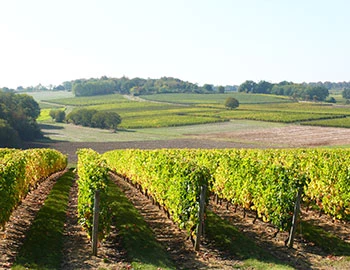Château Villars 2020
AC Fronsac, 750 ml

| Grape variety: | Merlot, Cabernet Franc |
| Producer: | Château Villars |
| Origin: | France / Bordeaux / Fronsac und Canon-Fronsac |
| Other vintages: |
Attributes
| Origin: | France / Bordeaux / Fronsac und Canon-Fronsac |
| Grape variety: | Merlot, Cabernet Franc |
| Label: | Vegan |
| Drinking temperature: | 16 to 18 °C |
| Food Pairing: | Beef Stroganoff, Goulash, boeuf bourguignon, Châteaubriand, Filet Wellington |
| Vinification: | fully destemmed, fermentation in cement tank, protein fining |
| Harvest: | hand-picking, strict selection |
| Maturation: | in partly new and used barriques/ Pièces |
| Bottling: | no filtration |
| Maturation duration: | 12 months |
| Volume: | 14.5 % |
| Note: | Contains sulphites |
Cabernet Franc
Forefather of the Bordeaux varieties
The Cabernet Franc is one of the oldest varieties of Bordelais and a parent of three other red grapes in the Bordeaux assortment: Cabernet Sauvignon, Merlot and Carmenère. It is distinguished by its complex, flavourful bouquet of raspberry, graphite, violet, liquorice and white pepper. In addition, it presents round, crisp tannins which turn out less strongly than those of Cabernet Sauvignon. While the Cabernet Franc always appears as part of a blend in Bordeaux, it is pressed alone on the Loire. The most renowned appellations are Chinon and Bourgueil. Incidentally, the Cabernet originates not in Bordeaux but in the Spanish Basque Country. Cabernet owes its name to the Latin “carbon”, meaning black.

Fronsac und Canon-Fronsac
Fronsac and Canon Fronsac: in the best company
Somewhat off the beaten track of the prestigious premier crus and new super crus, winemakers in Fronsac and Canon Fronsac produce classic, well-structured and storable Bordeaux wines with an excellent quality to price ratio. Thanks to the well-proportioned hilly terrain and the medieval estates, this is rural Bordeaux at its most beautiful.

Bordeaux
Bordeaux: high prestige, high quality
With a total area of around 115,000 hectares, Bordeaux may not be France’s largest wine-growing region, but it is certainly its most prestigious. The range of wines produced here today is enormous: ranging from red everyday wines with a great relationship between price and quality to exclusive, and accordingly expensive, premier crus. Elegant white wines and noble sweet specialties round out the spectrum.

France
France – Philosophy in a bottle
According to French philosophy, wine should be an expression of the soil and climate. They use the word “terroir” to describe this. Terroir makes every wine different, and many especially good. French wine is regarded worldwide as an expression of cultural perfection. The French believe that humans are responsible for the quality of the berries, the vine variety for their character, and nature for the quantity. This philosophy can be expressed succinctly as: “the truth is the vineyard, not the man.”



